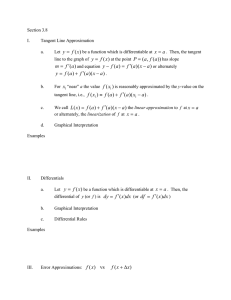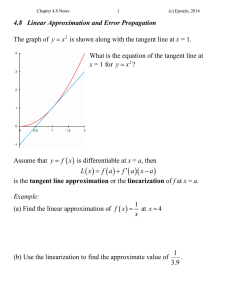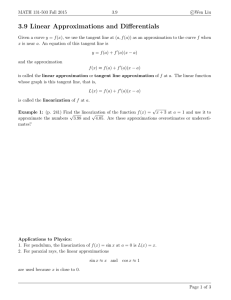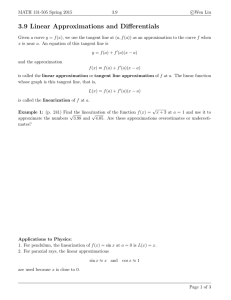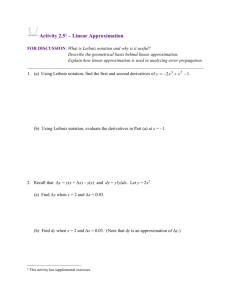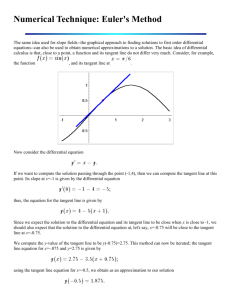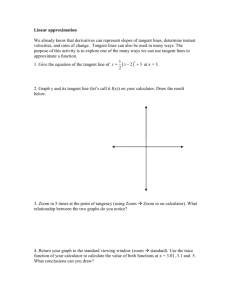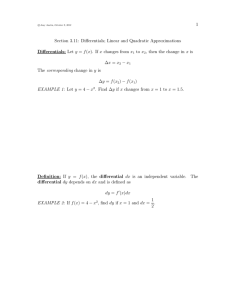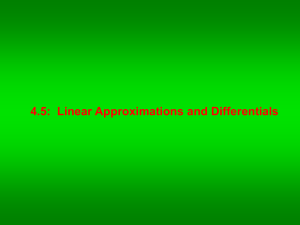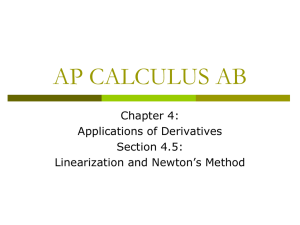Linear Approximations and Differentials
advertisement
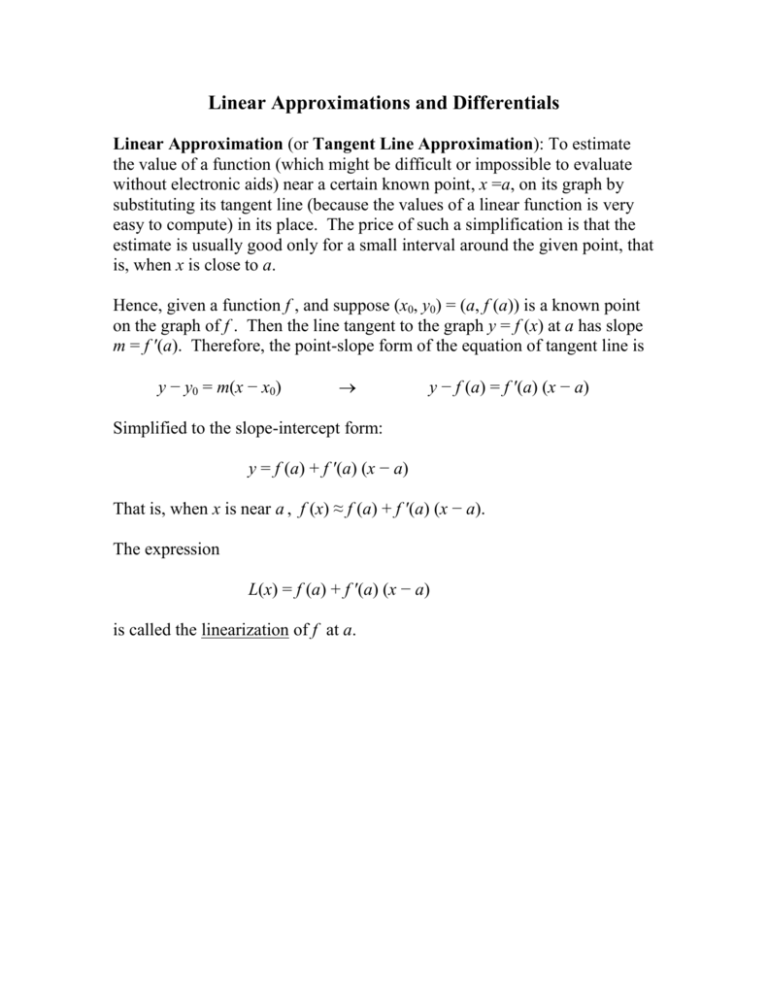
Linear Approximations and Differentials Linear Approximation (or Tangent Line Approximation): To estimate the value of a function (which might be difficult or impossible to evaluate without electronic aids) near a certain known point, x =a, on its graph by substituting its tangent line (because the values of a linear function is very easy to compute) in its place. The price of such a simplification is that the estimate is usually good only for a small interval around the given point, that is, when x is close to a. Hence, given a function f , and suppose (x0, y0) = (a, f (a)) is a known point on the graph of f . Then the line tangent to the graph y = f (x) at a has slope m = f ′(a). Therefore, the point-slope form of the equation of tangent line is y − y0 = m(x − x0) y − f (a) = f ′(a) (x − a) Simplified to the slope-intercept form: y = f (a) + f ′(a) (x − a) That is, when x is near a , f (x) ≈ f (a) + f ′(a) (x − a). The expression L(x) = f (a) + f ′(a) (x − a) is called the linearization of f at a. Ex. Use linear approximation to estimate the value of sin(1). First we need a known value of sin(x) near x = 1. The best point to use is at the reference angle π/3 ≈ 1.047, since it is the angle closest to x = 1. Hence, we will use the point (x0, y0) = (π/3, 3 /2). Let f (x) = sin x, then f ′(x) = cos x. The line tangent to y = sin x at x = π/3, therefore, has slope m = f ′(π/3) = cos(π/3) = 1/2, and passes through the point (π/3, 3 /2). Its equation is, therefore, 3 1 y x 2 2 3 Simplifying, 3 1 3 1 y x x 2 6 2 2 2 6 Hence, the linearization of y = sin x at x = π/3 is L( x ) 3 1 x 2 2 6 At x = 1, 3 1 1.732 3.1416 1 L(1) (1) 0.5 0.866 0.5236 0.8424 2 2 6 2 2 6 The actual value of sin(1) is 0.84147…, so the estimate is accurate within 0.001. Differential: To estimate the change in y-value of a function given the change in x-value. Here, the change in x, ∆x = dx, is considered to be the independent variable. The differential dy is the dependent variable and a function of dx. The relation between dx and dy is given by dy f (x) dx Therefore, dy = f ′(x) dx Here, the value of x is fixed at some number a, so it is actually a constant. The independent variable is dx, and dy is the dependent variable. Comment: The differential is just another way of looking at the linear approximation. When using the differential, we estimate the change in the y-value, as the x-value deviates from a fixed number a, rather than the new y-value itself. Notation: ∆x = dx is the change in x; ∆y = f (a + ∆x) − f (a) is the change in y (the actual change of function’s values from x = a to x = a + ∆x); and the differential, dy = f ′(x) dx, is the estimated change of function’s values from x = a to x = a + ∆x, according to the linear approximation of f at a. In other words, dy = L(a + ∆x) − f (a), where L(x) is the linearization of f at a. To see the relationship between differential and linear approximation, recall that the linearization of f at a is L(x) = f (a) + f ′(a) (x − a). When x is moved from a to a + ∆x, the expression becomes L(a + ∆x) = f (a) + f ′(a) ((a + ∆x) − a) = f (a) + f ′(a) ∆x Since ∆x = dx, L(a + ∆x) = f (a) + f ′(a) dx and dy = L(a + ∆x) − f (a) = (f (a) + f ′(a) dx) − f (a) = f ′(a) dx. Therefore, for any fixed value x, and a variable value dx dy = f ′(x) dx. Comment: Since linear approximations work best for values close to the fixed point a, so do differential become better estimates if the deviation dx becomes smaller (that is, if x is close to a). Ex. Compute ∆y and dy for y = (i.) ∆x = 1. (ii.) ∆x = 4. f ( x) x for x = 1 and 1 1 / 2 1 x 2 2 x At the fixed point x = a = 1, f ′(1) = 1/2. (i.) ∆y = f (a + ∆x) − f (a) = f (2) − f (1) = 2 − 1 = 0.414213… dy = f ′(1) dx = f ′(1) ∆x = (0.5)(1) = 0.5 Therefore, the linear approximation with base point a = 1 would give an estimate of f (1) + dy = 1.5 for the value of 2 , a reasonable estimate compares to the actual value of 1.414213… (ii.) ∆y = f (a + ∆x) − f (a) = f (5) − f (1) = 5 − 1 = 1.236067… dy = f ′(1) dx = f ′(1) ∆x = (0.5)(4) = 2 Therefore, the linear approximation with base point a = 1 would give an estimate of f (1) + dy = 3 for the value of 5 (compares to the actual value 2.236067…), which is not too good an approximation. The dx in this case is 4, which is too large a deviation from the base point, x = 1, to give an accurate result.
